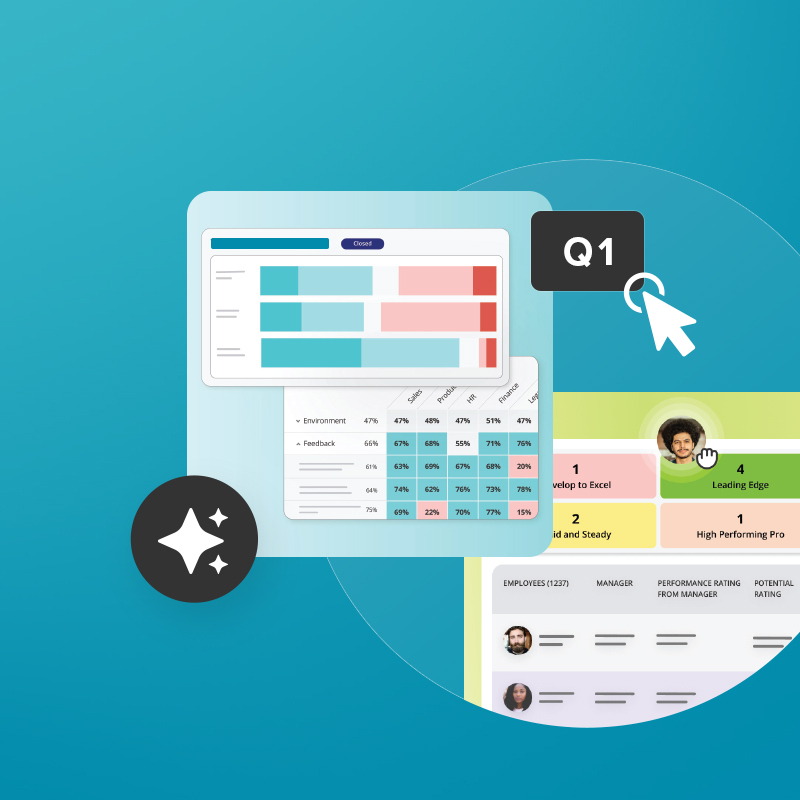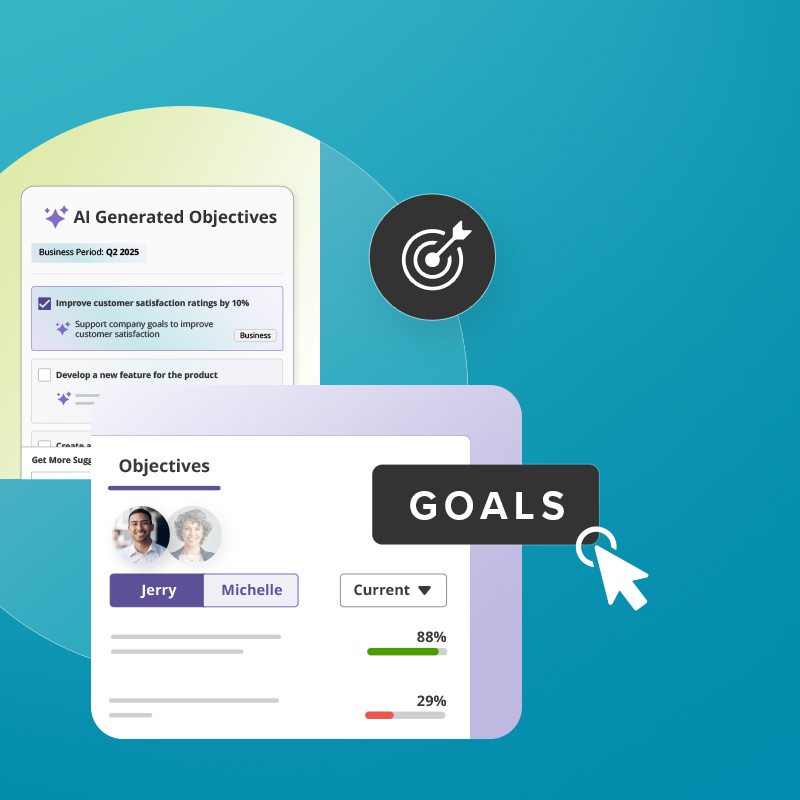OKR review meetings were originally introduced as a structured way to track progress and stay aligned on business outcomes. In practice, the execution often fell short of that vision.
When goal reviews are disconnected from feedback, coaching, or recognition, they lose their power. They become high-stress status updates instead of strategic conversations. That’s a missed opportunity.
Goals are most meaningful when they’re embedded in a modern performance management system, one that includes regular feedback, coaching, recognition, and engagement. In that context, they’re not just checkpoints. They’re tools for collaboration, growth, and smarter execution.
Why the ‘OKR review meeting’ model is outdated
The OKR review meeting was never supposed to be the meeting. It was meant to support performance, not become a separate ritual. But over time, it took on a life of its own. Instead of driving agility, it often winds up adding more lag. Here’s why:
- They’re rigid. The standard OKR cycle can’t keep up with shifting priorities and project velocity. Static timelines create pressure to “check the box,” even if the goals are no longer relevant. What started as an agile practice begins to feel just as stale as the annual review it was meant to replace.
- They’re disconnected. Goals are reviewed in silos, separate from performance conversations about feedback, coaching, or engagement. This disconnect dilutes their purpose and misses the opportunity to contextualize progress. When team members can’t see how goals relate to their development or daily work, motivation and clarity suffer.
- They lack context. Without real-time visibility or integrated feedback, review meetings become transactional. They don’t reflect the work behind the results or the obstacles along the way. This often results in surface-level discussions that fail to address the “why” behind the data.
- They burden managers. Prepping for a separate OKR meeting adds more lift to an already full plate. In many cases, it duplicates what could be covered in a regular check-in. Managers are left toggling between tools, prepping decks, and chasing updates just to get a partial picture.
The biggest flaw? These meetings reinforce the idea that goal conversations happen on a schedule, rather than as part of the rhythm of performance management. That might work in theory, but it doesn’t reflect how modern teams operate or how performance is actually managed day to day. In practice, this structure slows teams down and misses the opportunity to connect goal progress with the full context of employee growth, team collaboration, and business needs.
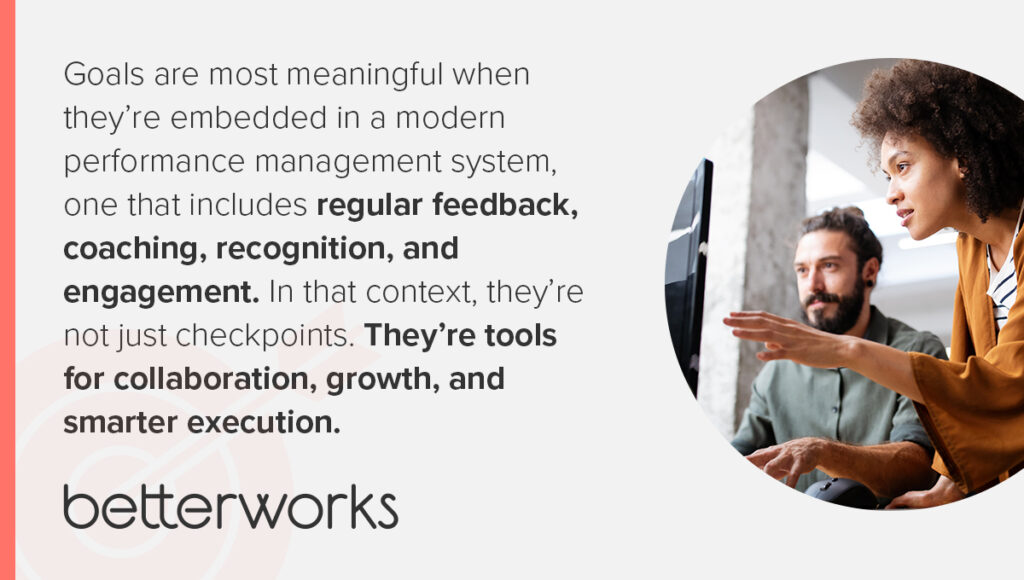
5 benefits of a more integrated approach to goal-setting
Many forward-thinking organizations are shifting away from one-off OKR meetings and toward integrated, ongoing conversations about progress. When goals live inside performance conversations—not beside them—everyone benefits.
Goals stay aligned to what matters most
When goals are a routine part of 1:1s and check-ins, they stay visible, relevant, and actionable. Teams stay grounded in what matters most and can shift course quickly when priorities change. It becomes easier to connect the dots between high-level strategy and execution, especially when tracking OKRs companywide.
Feedback has real impact
When feedback and goals are disconnected, conversations lose clarity. Integrated systems help link coaching moments directly to progress so employees understand not just how they’re doing, but why it matters. That clarity helps make feedback meaningful and timely—especially when it’s tied to OKR tracking.
Managers spend their time on the right things
Integrated systems reduce that burden by giving managers a clear view of progress, blockers, and recent feedback so they can show up to conversations ready to coach, not just report. When that context is baked into the process, goal conversations become sharper, more relevant, and easier to lead.
Recognition gets more strategic
In high-performing cultures, recognition isn’t random; it’s tied to impact. When goal progress is front and center, it becomes easier to call out wins and celebrate meaningful contributions in the moment. This reinforces progress, builds morale, and supports long-term motivation at both the individual and team level.
Goals drive engagement
When goals are woven into the broader fabric of performance conversations, employees feel a stronger sense of ownership. They see how their work ladders up to the bigger picture, and they’re more likely to stay motivated, aligned, and engaged, especially when ambitious goals are grounded in regular support.
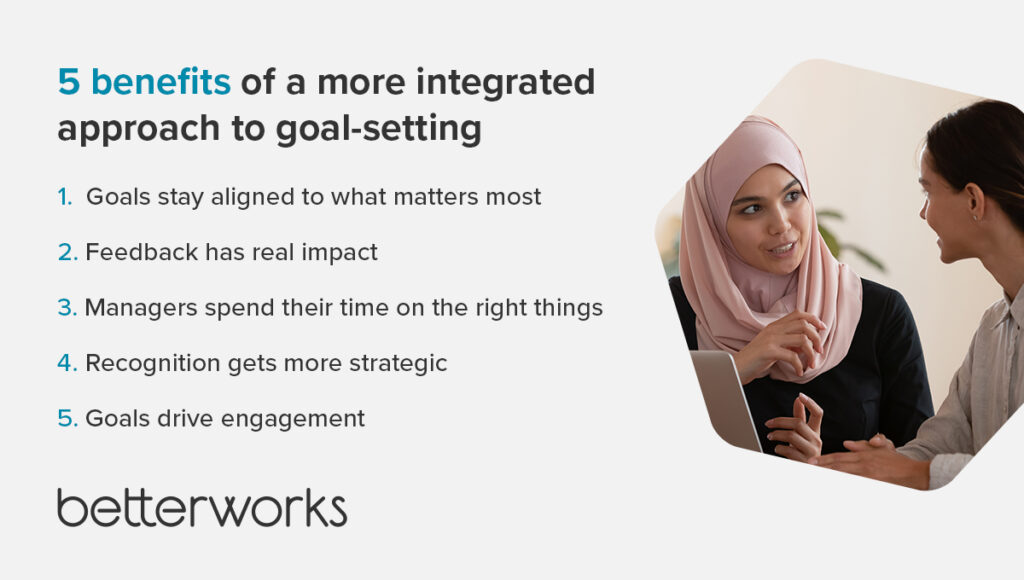
4 ways to rethink OKR review meetings
The idea here isn’t necessarily to replace OKRs or the concept of an OKR review. It’s to put them where they belong: inside the broader system of performance management, where they can actually support growth.
Stop treating goals as a separate process
Talk about setting goals in the same meetings where you coach, check progress, and unblock work. Don’t wait for quarterly reviews to bring them up. Performance management and goal-setting work best when they’re part of the same system. That includes setting OKRs and revisiting them alongside feedback, recognition, and lessons learned.
Make goal progress part of every 1:1
Build a few minutes into each 1:1 check-in to revisit OKR objectives and progress. Ask what’s moved, what’s stuck, and where support is needed. That steady cadence gives team members the support they need before goals go off track, and ensures you’re always aligned at both the individual and team level.
Adopt AI to help managers prepare
The right OKR software makes tracking OKRs less about updating a spreadsheet and more about enabling performance. Instead of requiring managers to dig through updates and spreadsheets, modern systems enable managers to use AI to surface goal-related insights automatically. That means less meeting prep time, better coaching, and more focused conversations—without adding friction.
Integrate goals with feedback, coaching, and recognition
Make sure your platform supports a full view of performance. Betterworks lets managers and employees track progress, give feedback, recognize wins, and stay aligned, all in one place. That integration transforms goals from static artifacts into strategic levers.
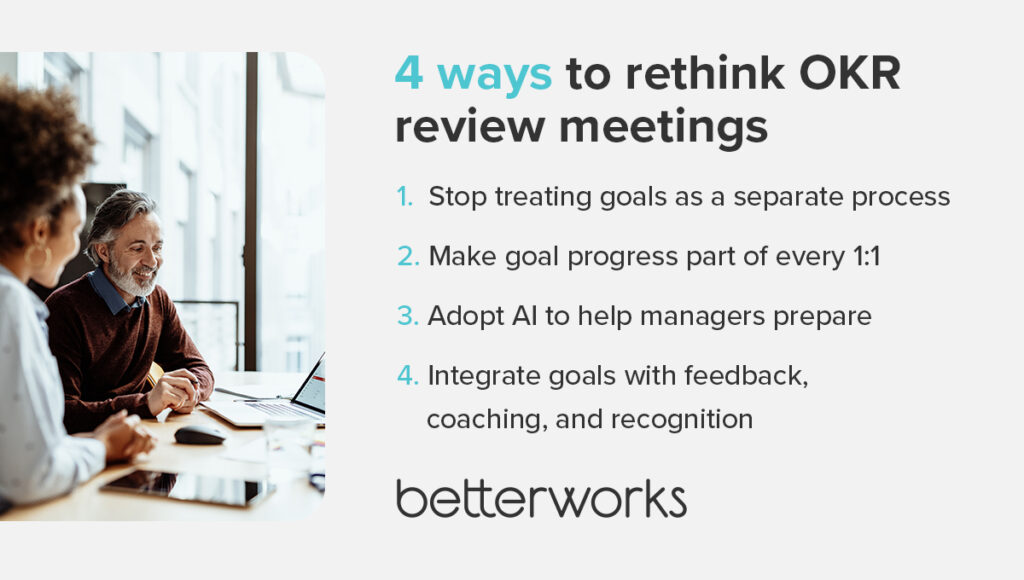
Continuous performance management starts with better conversations
The problem isn’t with objectives and key results. It’s that when goals are separated from the rest of the performance conversation, they lose their power.
Modern organizations are embedding goals into the rhythm of work, into every check-in, every coaching moment, every milestone. This is the essence of continuous performance management: keeping goals connected to feedback, recognition, and growth in real time. It’s not about more meetings—it’s about better ones. They’ve evolved the OKR meeting into a more meaningful touchpoint, one that supports alignment, unlocks growth, and keeps goals relevant in the moment.
If you want to cultivate an environment of trust to drive well-being, performance, engagement, innovation, and retention, learn how in 7 Ways to Build More Trustworthy Performance Management.
7 Ways to Build More Trustworthy Performance Management



